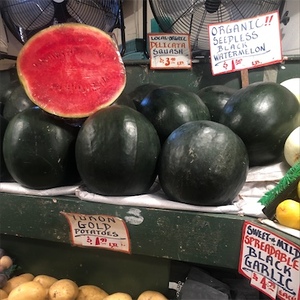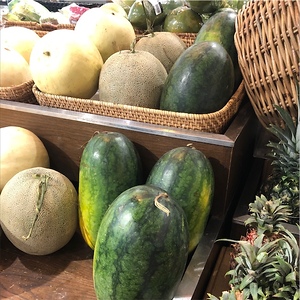


Black Beauty Watermelons
Estimated Inventory, lb : 0
Description/Taste
Black Beauty watermelons are a small to medium-sized varietal, averaging 2 to 2.5 kilograms in weight, and have an oval to oblong appearance with curved, blunt ends. The skin is smooth, glossy, tough, and semi-thick. The surface also showcases an emerald green base hue, covered in broken and mottled dark green-black striping. Underneath the surface, there is a thick layer of pale green rind that is firm, succulent, and crunchy. The flesh is dark red, dense, and aqueous with a tender and crisp consistency. The flesh also encases a few round to tear-drop-shaped black seeds. Black Beauty watermelons should feel heavy for their size and will produce a low-pitched sound when tapped, indicating a high juice content. The watermelon has a high sugar content, ranging from 12 to 14 Brix, contributing to a refreshing, sweet, and subtly fruity taste with faint vanilla, apricot, and banana nuances.
Seasons/Availability
Black Beauty watermelons are available year-round.
Current Facts
Black Beauty watermelons, botanically classified as Citrullus lanatus ‘Black Beauty,’ are a specialty variety belonging to the Cucurbitaceae family. The early-maturing cultivar is a popular variety in Asia, valued by growers for its resistance to disease, compact nature, and high yields, producing 2 to 4 fruits per plant. Black Beauty watermelons are named after their unusual dark rind coloring and are favored by melon enthusiasts for their sweet flavor, dense, juicy flesh, and smaller size. The variety is a common watermelon sold in local markets throughout Asia and is a rare, novel home garden variety in the United States and Europe.
Nutritional Value
Black Beauty watermelons are a source of vitamin C to strengthen the immune system while reducing inflammation, fiber to regulate the digestive tract, and potassium to balance fluid levels within the body. The watermelons also provide lycopene, pigments in the flesh with antioxidant properties to protect the cells against free radical damage and contain other nutrients, including vitamin A, copper, magnesium, phosphorus, and B vitamins.
Applications
Black Beauty watermelons have a refreshingly sweet flavor well suited for fresh and cooked preparations. The variety is most famous for eating straight, out of hand, and can be sliced into wedges, cut into cubes, or balled and tossed into a fruit bowl. Black Beauty watermelons can also be displayed on appetizer platters, mixed with sesame oil, garlic, vinegar, and sugar as a flavorful side salad, served on skewers, tossed into green salads, or combined with fresh herbs and other aromatics. In addition to fresh preparations, Black Beauty watermelon flesh and rind can be incorporated into soups, stir-fries, and salads or served with seafood that has a light flavor profile. The flesh can also be seared in a pan and covered in sauces, cheeses, and herbs or added to dessert preparations. In China, watermelon slices are commonly layered with cream, strawberries, and almond dacquoise to create a sweet dessert. They are also mixed into a fermented sauce made with watermelon and soybeans. This umami-filled sauce is traditionally served with steam buns, meats, and side dishes. Beyond culinary dishes, the flesh is often blended into smoothies, fresh juices, cocktails, or mixed with condensed milk to make a creamier drink. Black Beauty watermelons pair well with fruits such as pineapple, strawberries, blueberries, mangos, peaches, cantaloupe, and grapes, herbs including mint, basil, and parsley, cucumbers, leafy greens, ginger, balsamic, and honey. Whole, unopened Black Beauty watermelons will keep up to ten days when stored in a cool, dry, and dark location.
Ethnic/Cultural Info
Watermelons are one of the most popular summer fruits in China. The flesh is viewed as a cooling food, providing hydration to reduce the internal body temperature, and slices are often frozen to create an even cooler experience. Black Beauty watermelons are considered a common cultivar in China and are an affordable, compact variety with sweet, juicy flesh. Each year on August 7th or 8th, watermelons are customarily consumed to mark the end of summer and acknowledge the changing seasons. This ancient tradition of eating watermelon on the day of the seasonal change is known as ken qiu, meaning “biting into autumn.” Consuming summer fruits on this day is rumored to help protect the body against sickness caused by fluctuating seasons. Elementary schools, especially in northern China, enjoy honoring this tradition by slicing and serving watermelon varieties such as Black Beauty. The watermelons are cut into round medallions or slices and are given to the students to see who can eat the pieces the fastest. In addition to consuming the flesh, watermelon seeds are also used in Asia and are believed to have anti-aging properties. In Traditional Chinese medicine, watermelon seeds are dried, boiled, and made into tea. The seeds are believed to help aid in healthy skin and hair, lower blood pressure, and strengthen kidneys. They are also a good omen for fertility.
Geography/History
Black Beauty watermelons are believed to be descendants of watermelon varieties that originated in Africa and were carried along trade routes into China sometime during the 10th century. Once introduced, the ancient melon varieties were extensively bred, allowing new types to be created, including Black Beauty watermelons. Much of the variety’s history is unknown, but the watermelons are easy to cultivate, thrive in various soils, and grow in temperate, tropical, to subtropical locations. Today Black Beauty watermelons are primarily produced in Guangxi, Fujian, Ningxia Hui, Shaanxi, Hainan, Hubei, and Hunan provinces in China and are sold through markets, grocers, and growers. Outside of China, Black Beauty watermelons are found in local markets and select online retailers in Southeast Asia, including but not limited to Thailand, Taiwan, Malaysia, and India. The variety is also sold through online seed companies for home garden cultivation worldwide.
Recipe Ideas
Recipes that include Black Beauty Watermelons. One
| Oh So Delicioso |
|
Watermelon Mint Lemonade |
| Creative Homemaking |
|
Watermelon Jelly |
| The Kitchen is My Playground |
|
Kid-Friendly Watermelon Slush |
| Aberdeens Kitchen |
|
Watermelon Strawberry Cucumber Salad |

















